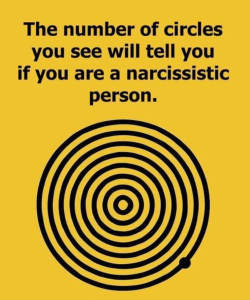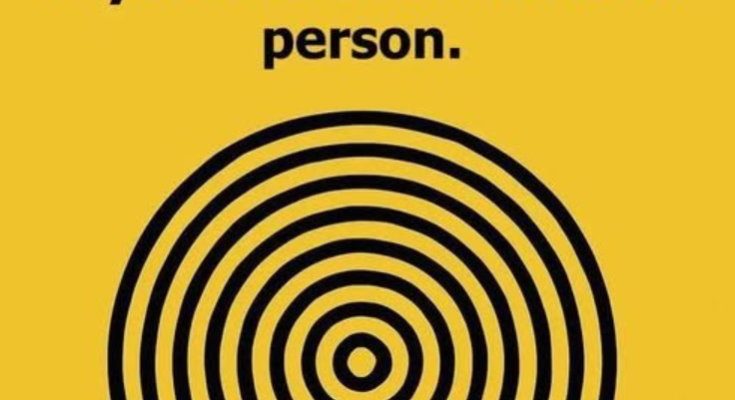The Hidden Puzzle Behind the Circles
At first glance, the image looks simple: black concentric circles on a yellow background. But the longer you stare, the more your perception shifts. Some people will swear they see ten or more separate rings, while others insist it’s just a spiral or one continuous loop. The graphic is designed to play with the way our brains process patterns and boundaries.
The twist? The caption suggests that the number of circles you claim to see reveals whether you’re narcissistic. Of course, that’s more of a playful psychological tease than a scientific measure, but it does get people thinking: Why do we all see something different?
Why Our Brains Disagree on What We See
Human vision isn’t just about eyes—it’s about interpretation. Our brains love to simplify and organize information. When confronted with repeating shapes, lines, and spirals, the mind tries to group them into the most recognizable pattern.
-
Some people’s brains interpret the black rings as separate circles, each distinct from the next.
-
Others immediately see it as a spiral, a single path winding inward.
Neither is wrong. The drawing is a clever hybrid: what looks like a series of rings is actually just one continuous line circling inward, giving the illusion of multiple circles.
This is where perception comes in. If you’re detail-oriented, you may count each band as separate. If you’re more focused on overall patterns, you’ll notice the spiral.
But What About Narcissism?
The caption’s claim—that the number of circles you see “tells you if you’re narcissistic”—isn’t grounded in clinical psychology. Narcissism is a personality trait involving self-centeredness, need for admiration, and lack of empathy. Diagnosing it requires careful evaluation by professionals, not a quick glance at a picture.
So why does this image connect circles to narcissism? Likely because internet personality tests often use visual puzzles to spark curiosity. People love the idea that their instant reaction reveals something hidden about them. It’s entertaining, not diagnostic.
But if we stretch the metaphor, there are ways to link the illusion to personality:
-
A narcissistic person might insist their interpretation (spiral vs. circles) is the only correct one—ignoring that others see it differently.
-
Someone more open-minded might accept that perception varies and both answers can be valid.
In this sense, the test is less about narcissism itself and more about how rigidly you stick to your viewpoint.
Why We Love These Kinds of Illusions
Images like this spread quickly online for a reason. They tap into several psychological triggers:
-
Curiosity – We want to know what our perception says about us.
-
Competition – People compare answers, sparking debates in comments: “I see 12!” “No, it’s just one spiral!”
-
Identity – We love simple explanations for complex traits. Even if it’s silly, the idea that a picture could reveal narcissism feels intriguing.
-
Entertainment – It’s fun. Like horoscopes, optical illusions let us explore ourselves without the heaviness of formal psychology.
The Science of Seeing
If we step away from the pop-psychology claim, the real story is about visual perception and illusions.
Our brains use shortcuts, called Gestalt principles, to interpret shapes. One of these principles is closure—the tendency to see complete shapes even when lines are broken or continuous. In this image, closure convinces some viewers that the spiral is actually a series of circles.
Another principle is figure-ground perception, the ability to separate objects (the black lines) from their background (the yellow). The bold contrast makes the shapes stand out strongly, tricking the eye even more.
Circles as Symbols
Beyond psychology, the circle itself is loaded with meaning. Across cultures, circles represent:
-
Unity and wholeness – The endless loop with no beginning or end.
-
Cycles – Nature’s rhythms: seasons, life and death, repetition.
-
Focus – A target or center point.
By asking how many circles you see, the image indirectly asks: How do you see wholeness? Do you break it down into parts, or embrace it as one connected flow?
This interpretation could link to self-focus. Narcissism, after all, often involves being at the “center of one’s own circle,” seeing the world revolve around oneself.
Narcissism in Popular Culture
The rise of images like this coincides with a broader cultural fascination with narcissism. In the age of social media, the term is everywhere: “narcissistic exes,” “toxic influencers,” “selfie culture.”
People are quick to label others narcissistic, sometimes without understanding that narcissism exists on a spectrum. Everyone has some degree of self-focus—it’s part of being human. But when it becomes extreme, interfering with relationships and empathy, that’s when it crosses into disorder.
An image like this plays on that cultural moment. It teases our fear of being labeled self-centered while giving us a lighthearted way to explore it.
The Playful Truth Behind the Test
So, does seeing ten circles instead of one spiral mean you’re narcissistic? No. What it means is:
-
Your brain organizes patterns in a certain way.
-
You might be more detail-oriented or more holistic in your perception.
-
Your interpretation can spark fun debates—but it doesn’t define your personality.
The deeper meaning might be this: how you respond when others see differently reveals more about you than what you see yourself. If you laugh, accept, and share perspectives, you’re flexible and empathetic. If you argue, dismiss, or insist your answer is the only truth, that rigidity could signal self-centeredness—not clinical narcissism, but a stubborn streak.
Why We Can’t Look Away
At its heart, this illusion is a reminder that our minds are trickier than we realize. Something as simple as black lines on yellow can expose the fascinating ways we perceive, interpret, and argue about reality.
And maybe that’s why the image resonates. It’s not really about narcissism at all. It’s about the human desire to understand ourselves, to turn even a spiral of circles into a story about personality, identity, and meaning.
Conclusion
The viral image claiming “the number of circles you see will tell you if you are a narcissistic person” is more playful than scientific. It’s an optical illusion designed to divide opinions, spark conversation, and make us question how we see the world—and ourselves.
In truth, it reveals less about narcissism and more about perception, personality, and human curiosity. Whether you saw a spiral, a handful of circles, or lost count trying, the fun lies in realizing that perspective is subjective.
Perhaps the real lesson isn’t about narcissism at all. It’s about humility: accepting that what we see isn’t always the whole picture, and that someone else’s truth might look different—but still be valid.


